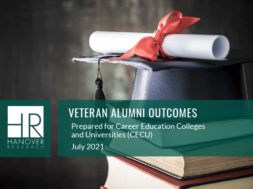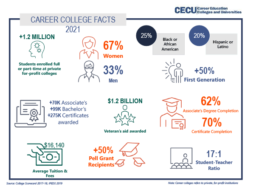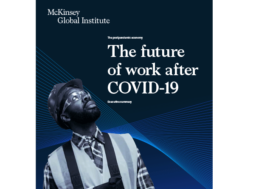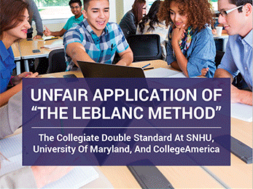
Attracting and Engaging Students in Today’s Environment
By Carol Aslanian, Founder and President, Aslanian Market Research, EducationDynamics
Although the education landscape has shifted dramatically over the course of this past year, the need to reach today’s students has remained the same. We surveyed over 3,000 current and prospective students over the course of 2020 to measure the demands and preferences of today’s online and post-traditional students, and how they are shifting.
Higher education, and particularly online higher education, have been dealing with increasing questions into the value and return on investment in terms of both time and money. Tuition costs continue to rise. Under the financial constraints and job losses of the pandemic, students and their families have become even more sensitive to the costs and value of pursuing a degree.
Responding to the sudden shift to distance learning demands that schools invest significant capital while also coping with a reduction in revenue. Only time will tell how COVID-19 will impact traditional student enrollment in the future. Certainly, the non-traditional student market will remain important for colleges and universities. The pandemic has accelerated demand for online, and high unemployment will likely generate interest in programs that align with desired outcomes. Much energy is being spent on coping with traditional students and creating a pandemic response for on-campus students. Schools that invest well today will be well-positioned to serve this growing segment of the student population.
Students will continue to seek areas of study that will offer the incomes they need to support themselves and their families. Institutions must recognize this major motive in their decision to return to school and offer programs that are well matched to their needs.
Today’s post-traditional students, defined as any student other than those students who study full time, during the day in a classroom setting and live on or near campus, have an average age of 31 for undergraduates and 33 for graduates. Undergraduate post-traditional students most often first enroll in college immediately after completing high school (37%), but equal proportions of those students who did not enroll right away waited one or more years. (Aslanian & Fischer, 2020) Overall, graduate post-traditional students enroll in graduate school within five years of completing their undergraduate studies (71%). They most often enroll in graduate school three to five years after completing their undergraduate studies (30%) (Aslanian & Fischer, 2020).
Post-traditional students of today demand flexibility. This includes differing formats, shorter courses, and a host of other delivery options. They connect differently to institutions; rather than visiting college fairs, they do their own research and know what they want when they make their initial contact. It is to no surprise that 27% of these students begin or continue their studies because of a new financial or career situation (Aslanian & Fischer, 2020). Specifically, they are seeking an increase in salaries, career advancement, or a new career direction. These same students want to earn their degrees and enter the job market as quickly as possible. Post-traditional students most commonly expect to change or advance their job or career within one to five months of graduating, and the majority expect to do so within 11 months (Aslanian & Fischer, 2020). They are likely to be attracted to courses in business, health and computer & IT which ultimately correspond with their desired career after graduation. (EducationDynamics, 2020)
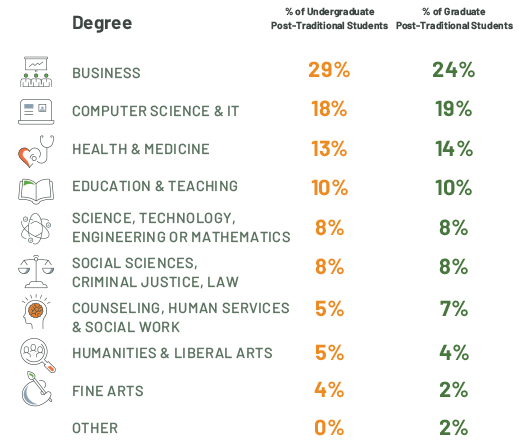
While both undergraduate and graduate students expect career-related outcomes from their degrees, they have very different outcomes in mind. Half of post-traditional undergraduate students are seeking job advancement, while a third want to change careers or jobs. Graduate post-traditional students are much more likely to be focused on making a career change, while only 30% are expecting to advance in their current career or job (EducationDynamics, 2020). Undergraduate post-traditional students expect to begin their studies between one and eight weeks after submitting their application. Graduate post-traditional students expect their studies to start between two and eight weeks after submitting their application (Aslanian & Fischer, 2020). Colleges that want to attract these students must adapt their procedures and responses to match the preferences of these students.
Reaching today’s students requires focusing attention on several factors. Across multiple studies, we repeatedly find that affordability and cost is the number one determining factor. Forty-six percent of undergraduates list cost in their top three decision factors, while 51% of graduates site cost as a top 3 determining factor (Aslanian, Reaching Today’s Students, 2021).
While cost continues to be at the top of the list for student enrollment factors, there are a few other determining elements at play. School reputation and the length of time needed to complete a degree are both incredibly important to today’s students. Successful schools will best stand out among a myriad of institutions in regard to reputation, cost effectiveness, and attainment of a degree or other credential in the shortest amount of time possible.
Not surprisingly, 2020 saw an increase in the demand for online and blended programs. While some of this may have been temporary due to the pandemic, the shift toward online programs seems to be real and lasting. Among both undergraduate and graduate post-traditional students, the largest proportion (roughly 25 percent) of undergraduate and graduate students, took all their courses online with no visits to a campus. Next, most often, they enrolled in “low residence” programs that required minimum – one or more days – visits to campus. Hybrid course preference followed next. Finally, and most revealing, more than one-half of students who were looking to take an online course at a college or university that did not offer it said they would turn to an entirely different school to find the courses they were seeking (Magda, Capranos, & Aslanian, 2020). Needless to say, it is important to examine and review your degree programs both in-person and online and make sure they are attractive to your targeted audience of students.
Support services in certain areas are becoming more and more important to prospective post-traditional students. We cannot underestimate the value of career services to this population, given the fact they are totally participating in higher education for career reasons. Among a wide variety of services presented to them, students believe the most important to them are career planning and placement services. Ties to employers would be key as well as resume development, availability of a career advisor, self-assessments, job search assistance, and so forth (Aslanian & Fischer, 2020 and Beyond, 2020).
These types of services would be highly attractive to prospective students given their motives for returning to school and their primary motivation related to career development.
Another key pattern to recognize in developing a college’s marketing plan to attract a larger number of post-traditional students is to recognize, as our data shows, that close to 70% of post-traditional students reside 50 miles or less from the school in which they were enrolled (Aslanian & Fischer, 2020 and Beyond, 2020). In the last year, 83% of enrollments originated from in-state residents for public institutions. However, for-profits and private non-profits saw enrollment from a wider geographic map. (Aslanian & Fischer, 2020).
This pattern has immeasurable value to the marketing staff of any institution. Where advertising resources are spent, where employers are sought as partners, where support services should be offered, and many other activities should take this important finding into consideration. Ultimately, the key to standing out among a larger array of competitors, though, is to be competitive in price, support services and ties to employers.
We offer these major patterns in higher education and advice as schools work diligently to attract growing numbers of post-traditional students to their campuses:
-
- Age no longer predicts learning. Post-traditional students are getting younger, and this pattern is likely to increase in the post-pandemic era. The term “adult” is unnecessary and dated. A student of any age should be able to enroll in any classroom, blended, or online program. Age-based programs and divisions/units need to drop age provisions and convert their appeal to students of all ages who want what they are offering, at a given price, with primarily online and blended format, at a convenient location.
- Offer 6-8 week courses back to back over the course of the academic calendar.
- Increase ties and partnerships with area employers to help in curriculum relevance and in assisting current students in meeting their employment goals.
- Streamline and offer hands-on assistance during the admissions process. Post-traditional students often need help in areas regarding financial assistance in particular. Drop application fees to help cut initial costs and make your program seemingly more attractive from the start.
- Offer robust student services, particularly those that focus on a student’s career motivations and goals. Offer such services over a lifetime. The lifelong learning movement may be here to stay as jobs and occupations continue to change.
- Align academic programs, marketing and communication with career outcomes. Today’s students are focused on the value they receive from the degree, often measured by the impact a degree will have on their career. Moreover, data indicate that both undergraduate and graduate students have a more focused motivation for career change or career advancement.
At EducationDynamics we continuously monitor the demands and preferences of the higher education landscape and its students. We specialize in services and solutions that touch the entire student lifecycle, from inquiry generation to enrollment management, marketing, branding, contact center services, and more. Get in touch with EducationDynamics today to learn more about how we can help you grow your enrollments from consideration to graduation.
References:
Aslanian, C.B., Fischer, Steven, (2020). 2020 and Beyond: Attracting and Serving Post-Traditional Students. Hoboken, NJ: EducationDynamics
Aslanian, C.B., Reaching Today’s Students. 2021
EducationDynamics, 2020. Beyond Benchmarks. Hoboken, NJ: EducationDynamics
Aslanian, C.B., Fischer, Steven, (2020). 2020 and Beyond: Attracting and Serving Post-Traditional Students. Hoboken, NJ: EducationDynamics
CAROL B. ASLANIAN, President and Founder of Aslanian Market Research, leads market research at EducationDynamics. Carol is a national authority on the characteristics and learning patterns of adult students and has made hundreds of presentations to educational institutions, state agencies, and national associations, focusing on her major area of expertise – access to higher education for place-bound and time-bound students.
Contact Information: Eric McGee // Director of Marketing and Corporate Communications // EducationDynamics // 803-760-5200 // emcgee@educationdynamics.com // educationdynamics.com

